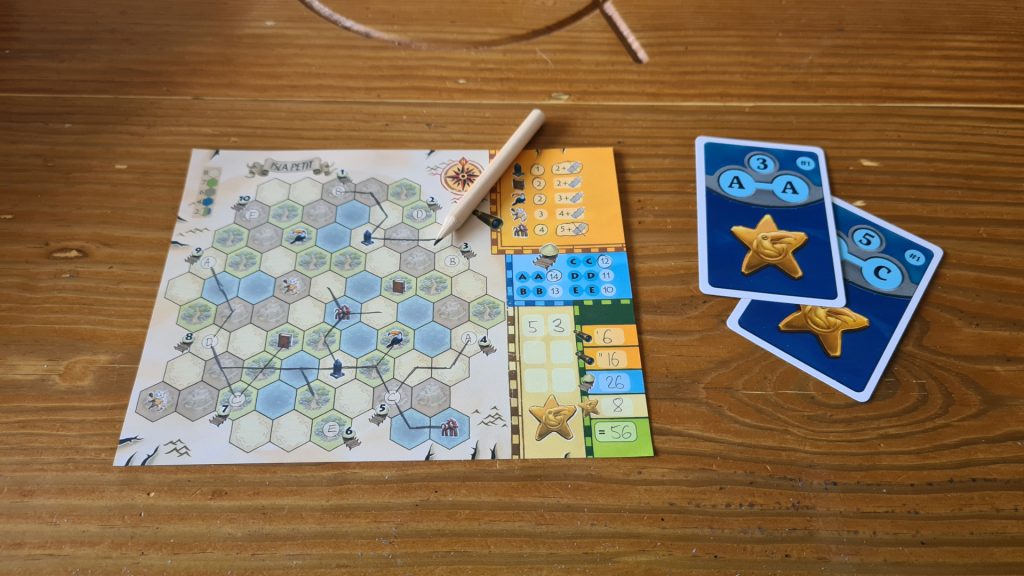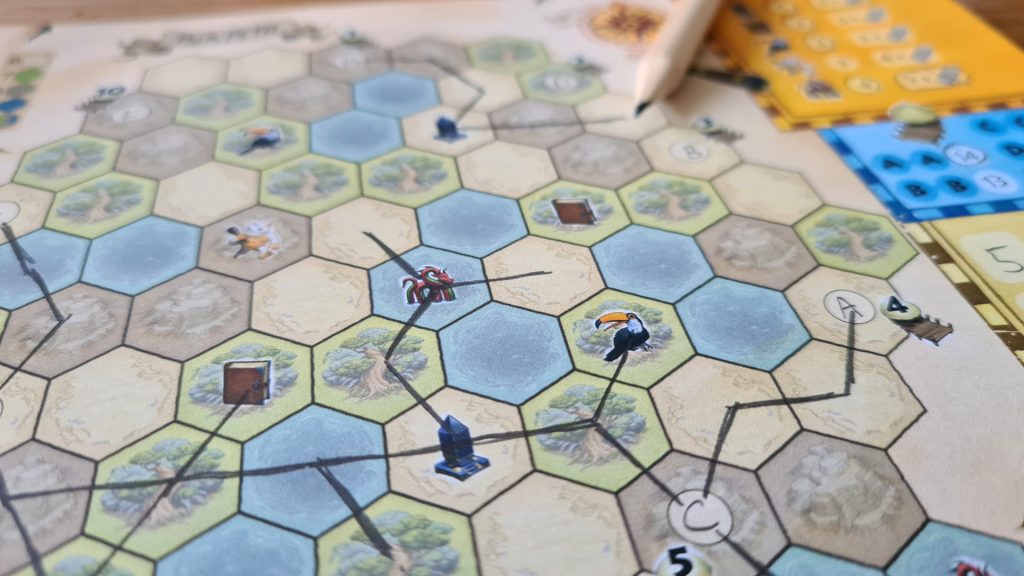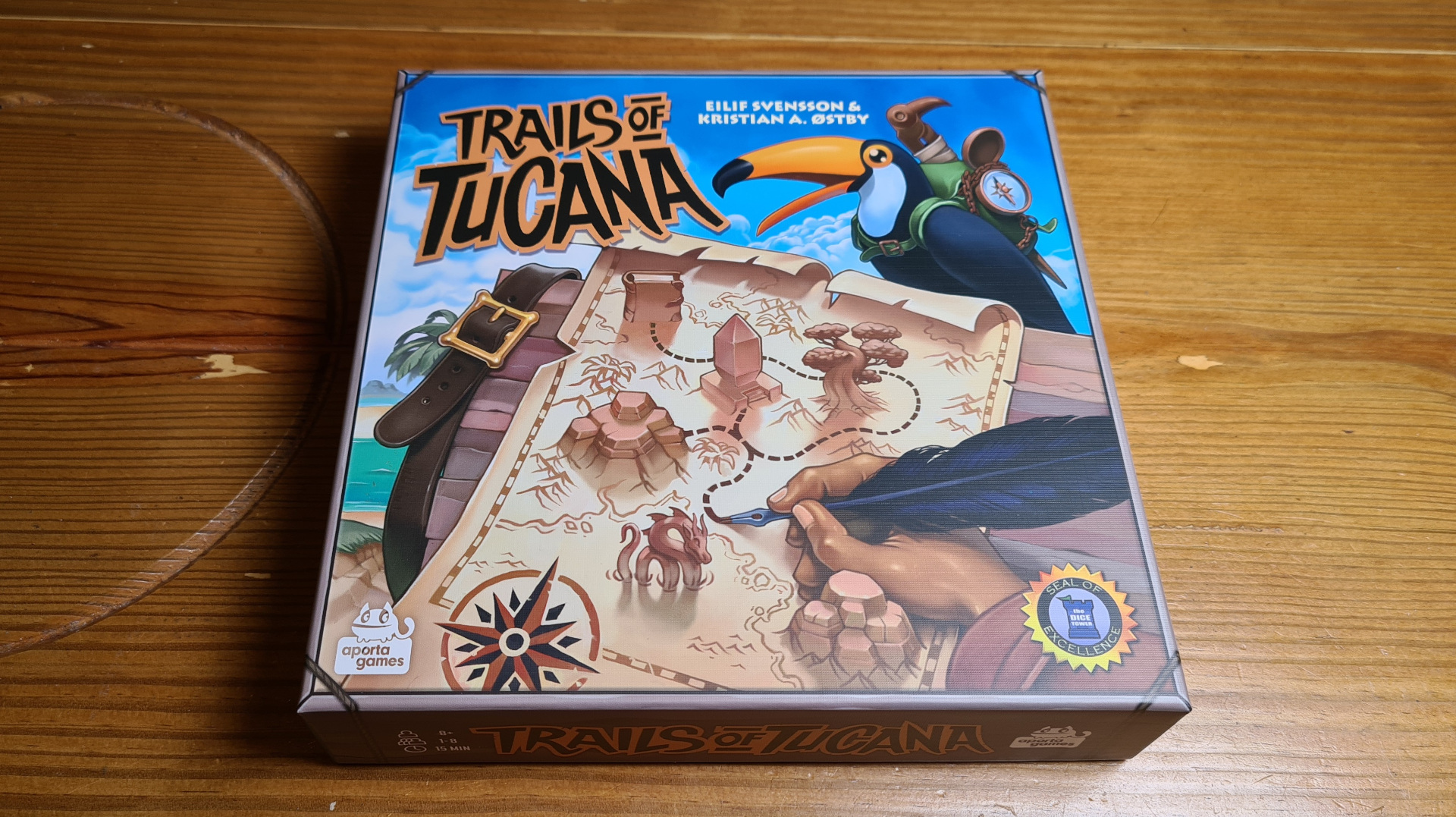Trails of Tucana is a flip and write, route building style, board game – published by Aporta Games. Designed by Eilif Svensson & Kristian Amundsen Østby, featuring artwork from Gjermund Bohne, the game sees 1 – 8 players journeying out across the island of Tucana – for around 15 minutes. Trying to visit sites along the way, trails will zigzag and weave across the island, linking villages together. However, is network route efficiency actually fun? Let’s find out!
Setting up the game, each player takes a map sheet and pencil from the box – with all players using either the Isla Petit or Isla Grande side. Using a set-up card the empty village spaces are assigned a letter, randomising the initial setup somewhat. Depending on the player count either the #1 or both #1 and #2 bonus cards are put into the middle of the table. Lastly the deck of 27 terrain cards is shuffled.
Each turn any player flips over the top two cards from the terrain deck. These are put into two separate piles and create a pair. All players then draw a trail line onto their map, linking any two adjacent hexagons of the two terrains. For example, if a water card and a sand card are flipped then all players can draw a link between any water and adjacent sand hex. Trails do not need to link to previously drawn trails, nor does it matter about branching paths or if a player doesn’t want to start from an edge.
The aim is to link the villages of the same letters together, and also link and sites to the villages. Each site symbol appears on the map twice. The first time a site type is linked to a village the player circles the first point value next to it on the scoresheet. When that player then links the second site of that type to any village they circle the second higher point value and importantly gets to add a single free trail to their map instantly.

Linking two matching villages sees the player circle the route on the score section of the sheet, gaining the denoted points at the end of the game. In a 2 – 4 player game whoever is first to link between matching villages, A to A for example, gains the bonus card – the A to A bonus card. In a 5 – 8 player game the second person to do so also gets a smaller bonus, with everyone else getting only the standard points for making the connection.
After everyone has used the pair of cards to draw a trail then the next pair is revealed and so on. When the deck is depleted the first round scoring commences. For all of their circled sites the players sum the points earnt, writing it down in their orange round 1 box. At this point nothing else scores, with the terrain cards gathered, reshuffled and round 2 commences. For the Isla Petit map, at the end of the second round the game is over. The circled sites are scored again, with completed linked trails and bonus points all being summed for a final score. For the Isla Grande map a third round is played before the final scoring, with the winner whoever has the most points.
After only a few turns, despite everyone using the same pairs of cards, each player around the table will have started to link completely different lettered villages and symbols. As the game progresses players will still be competing for the bonuses for linking different villages but the routes across their maps will look very different. Extending this are the bonus free routes that players get to draw for linking to the second of each site symbol. Effectively being wild to wild means it can be drawn anywhere and is like getting to draw a card pair that no one else has access to use.

For what seems like a simple choice each turn can be surprisingly thinky. Drawing a line between the two indicated terrains is instantly understood by players. Yet, the choice of where to draw lines can feel a little overwhelming for a few turns. Until you have a few route segments and a clear route to work towards, the blank canvas of a map is full of options. Those that suffer from analysis paralysis may as a result take a long time on every choice – though the game thrives when the pace remains decent. As soon as players start to have time to wait for others after every turn their immersion in the experience starts to wane.
For a flip and write Trails of Tucana is a rather colourful game. The vivid colours of the terrains on the cards aren’t quite captured by the map sheets, though these still are relatively bright colours, with colourful waters, green forests and more. Despite being made from smaller hexagons to cater for a bigger map the Isla Grande (reverse) map is still readable at a glance thanks to the colours used. The symbols being linked to are a bit odd, especially the angry cat like Yeti, still they are very distinct from one another.
On top of having two map designs and setup cards to randomise village positions, there are also a couple of variants – one being the Isla Grande map. Red backed bonus cards are the other and work in the same way as the standard ones, but see players trying to link two identical sites together. These are nice little addition, which drags players away from linking villages even more. Plus, with only 1 used for a 2 – 4 player game they don’t completely change the way the game plays either. One thing that feels like it is missing given the rest of the variety are different blue backed bonus cards. Each is always A to A, B to B etc. For added variety it is surprising that there aren’t some bonus cards for connecting say an A to an E or even going a step further and saying linking an A, B and C together. These aren’t needed but may have been interesting to shuffle in.
Trails of Tucana is somewhat of a surprise package. Each turn is full of options, despite all players using the same flipped over pair of cards. It can be taught in a matter of minutes and yet it has enough to keep new and veteran gamers engrossed. The vibrant colours and theming make the game visually pleasing, though don’t really add anything past the logic of drawing trails across the map. Trails of Tucana proves that flip and writes don’t have to just be about numbers and abilities, and has certainly earnt its space on my gaming shelf.
(Editor’s Note: Trails of Tucana was provided to us by Asmodee for the review. It is currently available from local board game stores! Find your local store here.)

